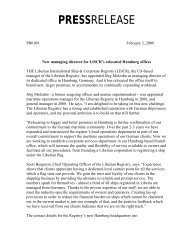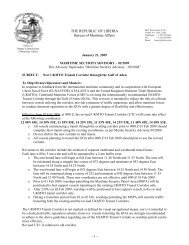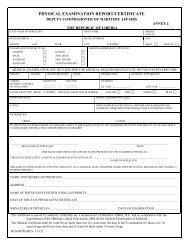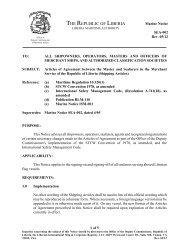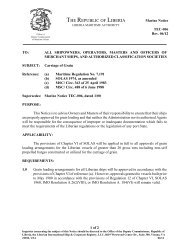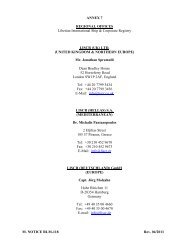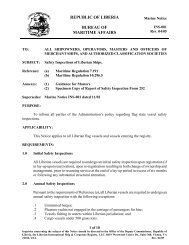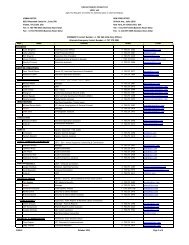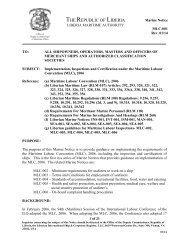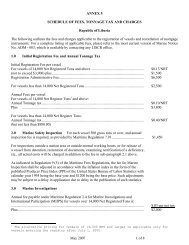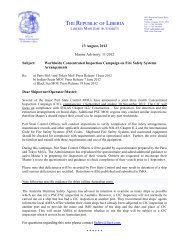You also want an ePaper? Increase the reach of your titles
YUMPU automatically turns print PDFs into web optimized ePapers that Google loves.
(Material Safety Data Sheets, etc), shall identify physical properties of the NLS, specialprotective equipment or unusual response techniques in a format consistent with section3.2 of these guidelines. Reference may be made to Data Sheet or similar documents thatidentify characteristics of NLS. A copy of such document should be kept with the plan,but need not be part of the approved plan. In addition to the checklists, specificpersonnel assignments for anticipated tasks must be identified. Reference to existing firecontrol plans and muster lists is sufficient to identify personnel responsibilities. Thefollowing are examples of casualties, which should be considered:.2.1 grounding;.2.2 fire/explosion;.2.3 collision (with fixed or moving object);.2.4 hull failure;.2.5 excessive list;.2.6 containment system failure;.2.7 dangerous reactions of cargo (for ships certified to carry NLSs);.2.8 other hazardous cargo release (for ships certified to carry NLSs);.2.9 loss of tank environmental control (for ships certified to carry NLSs);.2.10 submerged/foundered;.2.11 wrecked/stranded;.2.12 cargo contamination yielding a hazardous condition (for ships certified tocarry NLSs); and.2.13 hazardous vapor release.4.4.3 In addition to the checklists and personnel duty assignments mentioned in section 4.4.2, thePlan should provide the master with guidance concerning priority actions, personnel safety,stability and stress considerations, and lightening and mitigating activities.4.4.4 Priority actions - This section provides some general considerations that apply to a widerange of casualties. The Plan should provide ship-specific guidance to the master concerningthese broad topics..1 In responding to a casualty, the master’s priority will be to ensure the safety of personneland the ship and to take action to prevent escalation of the incident. In casualtiesinvolving spills, immediate consideration should be given to measures aimed atpreventing fire, personnel exposure to toxic vapors, and explosion, such as alteringcourse so that the ship is up wind of the spilled cargo, shutting down non-essential airintakes, etc. If the ship is aground, and cannot therefore maneuver, all possible sourcesof ignition should be eliminated and action should be taken to prevent toxic vapors orflammable vapors entering accommodation and engine-room spaces. When it is possibleto maneuver, the master, in conjunction with the appropriate shore authorities, mayconsider moving his ship to a more suitable location in order, for example, to facilitateemergency repair work or lightening operations, or to reduce the threat posed to anyparticularly sensitive shoreline areas. Such maneuvering may be subject to coastal Statejurisdiction..2 Prior to considering remedial action, the master will need to obtain detailed informationon the damage sustained by his ship. A visual inspection should be carried out and allcargo tanks, bunker tanks, and other compartments should be sounded. Due regardshould be paid to the indiscriminate opening of ullage plugs or sighting ports, especiallywhen the ship is aground, as loss of buoyancy could result.POL-003 7 of 29 Rev. 06/12The Republic of Liberia



